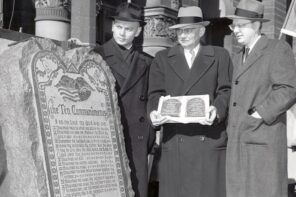Among the other odd and entertaining sights that spelled last Halloween night in San Francisco—Michael Jackson on the MUNI bus, Barbara Streisand teetering on four-inch heels at Starbucks—was this one: comix artist Robert Crumb onstage at the San Francisco Jewish Community Center, headlining the Jewish Book Fest at its sold-out opening event.
Basically it was the usual Jewish Bay Area crowd, coming out in droves for Crumb, who had apparently become an honorary member of the tribe by illustrating that tribal book of ours, Genesis; no doubt a few of them were just now being introduced to Crumb, through his freshly-minted biblical pedigree. But there were some hipsters standing in line to buy a copy ($60 for the autographed version) who looked as if they had never set foot in a JCC before, and who were only reading the Bible now that Crumb had, so to speak, recommended it. Among that group was Crumb’s elegant onstage interlocutor, Françoise Mouly, the art director of The New Yorker, who began by confessing, “You know, Bob, I never actually read the Bible before you showed me your illustrations,” to which Crumb gamely answered, “No, of course not, why would you?”
For those of us who were reasonably familiar with both the Bible and underground comix, the experience was not of being introduced either to a new artist or to an ancient literary work but rather of their unexpected juxtaposition: Where Genesis and Crumb had until now occupied distinct areas of the brain or psyche (the academy versus the comic book store? The cerebrum versus the reptilian cortex? The superego versus the id?), they now coexisted on the cramped quarters of a single page. There are some peculiar pleasures in the union of these realms, in a biblicized Crumb, a Crumbulated Genesis.
A Certain Crumbitude
The unspoken assumption in most reviews I’ve seen is that the latter is the more interesting phenomenon, or at least the more important one, with the greater cultural stakes. As others (including Robert Alter, whose translation undergirds most of Crumb’s text) have commented, Crumb’s illustrations quite literally flesh out the biblical stories, giving face and form—and nipples, backsides, lips, teeth, and hair, lots and lots of hair—to its characters, including the especially hirsute character of God (a kind of manlier and more ancient Mr. Natural, with an even longer beard); the names of the Genesis genealogies, Mehalel and Jared and Enoch and so on, who’d barely registered in consciousness before (even the rabbis are uncharacteristically silent in the face of these endless begats), come to life again, recognizably products of Crumb’s art but nevertheless individual people, with unique and distinct faces.
What seems to have surprised many of the reviewers, including this one, is not only how “straight” Crumb played the Bible, but also how far from jolting even the most striking of these illustrations are, as if he were not imposing an alien and coarse modern sensibility on an exalted ancient text but rather uncovering a certain Crumbitude that had always been inhabiting it. There was, it seemed to me, an affinity between whatever it was Crumb stood for (sexual lewdness as well as emotional honesty, a fascination with the unbeautiful body, the interconnections between desire and vulnerability or beauty and power) and whatever Genesis had on offer.
What does it mean that the Genesis that emerged from Crumb’s eccentric pen could nevertheless seem so familiar, that there should be no mismatch between Crumb’s idiosyncratic style and a book of such broad and, to many readers, sublime reach as the Bible? Could it be just a kind of fortuitous connection between the mythology of Genesis and the background to Crumb’s coming-of-age as a comic artist among the stoned biblical types that rolled half-naked around the Eden of Golden Gate Park? Was the missing link in the evolutionary scheme that begins with Creation and ends with Crumb on the JCC stage not a half-upright ape but just a shaggy hippie?
Of course these are surface similarities, and the criticism of Crumb’s version has been that it reduces the Bible to surfaces, to “mere” appearance. Buber once said, though, that what was needed in the case of the Bible was not more and deeper digging but rather a return to the surface, through the layers of “meaning” and “significance,” the accretions of interpretation and tradition that had buried the biblical story until we couldn’t see the nose on its face. The fleshiness of Crumb’s characters is not foreign to the biblical worldview: The “hairy mantle” that covers the newborn Esau is a key to his character and, a few chapters later, a pivotal plot point. Crumb’s visual translation brings us back to that forgotten surface, lost not only to the pieties of religious readings but inevitably also to its translation out of Hebrew.
As Buber also pointed out, Hebrew is much richer in corporeal language than the languages of its greatest translations: the preposition translated as “before” is, in Hebrew, “to the face” [lifney], while the word yad (hand) appears in a host of prepositions and expressions and the literal meaning of the biblical term for “patience” is, somewhat more oddly, “length of nostrils” [erekh apayim]; a trace of this use of the body as touchstone for all relations in space survives in the KJV rendering of “surface” as “face” in Genesis 1:2: “And darkness was upon the face of the deep.” What Buber argues is that the profound Hebraic connection between the material and spiritual universe, in which the single word ru’akh means wind AND breath AND spirit, has been lost in the spiritualizing afterlife of the Bible.
Crumb’s illustrations do not merely restore the physical dimension suppressed by theologizing abstraction, at their best they convey that there are no differences between these realms, as there is none between—in one of the more charged corollaries of the distinction between Earth and spirit—sex and love. My favorite illustration in the book is for the last verses of Genesis 24, in which Isaac “brought [Rebecca] into the tent of Sarah, his mother, and took Rekah as wife, and he loved her, and Isaac found solace after the death of his mother.” The panel shows the lovers lying spent among the voluptuous, almost vaginal folds of Sarah’s tent, Isaac fingers half-buried in Rebecca’s wavy hair, a leg wrapped around her ample hips, both of them with eyes half-closed.
If this picture forthrightly restores something integral about the earthy-sublime worldview of Genesis, it also gives us another angle on its creator, spiritualizing the Crumb most known for his raunchiness. The book is dedicated, without further comment, “to Alene,” Crumb’s Jewish wife—and a comix genius in her own right. Alene is everywhere in the Crumb’s rendition of female characters of Genesis, as if he in taking on the task of illustrating Genesis he had also committed himself to discovering the primeval but nevertheless recognizable ancestors not only of his Jewish wife but also of all those other strong-featured, wavy-haired, prominently-nippled Amazons that have populated Crumb’s comics for decades.
“The Footwear, Show Me the Footwear!”
During the Q and A at the JCC event, waiting her turn in the line going up one aisle, was Crumb’s wet dream in the flesh, the two pigtails, breasts like projectiles, shoulders like a linebacker, short skirt over full thighs. She was speaking, but Reb Crumb clearly wasn’t hearing a word: “The footwear, show me the footwear!” On the laptop before her, Mouly found and clicked on the appropriate image, as she’d been deftly doing all evening—and on the screen behind them appeared a self-portrait of the young Crumb, sniffing the inside of a woman’s boot. The woman clomped onto the stage and leaned over the distinguished guest speaker, who was theatrically wiping his brow. On her feet, shiny Mary Janes with two-inch platforms, over the surreally muscular calves that signal, in Crumb’s universe, the apotheosis of female desirability. Crumb may have been putting on an act, but the rest of us were in genuine ecstasy.
In case you’re wondering, I’m a feminist. But as lewd and even grotesque as Crumb’s depictions of women undeniably are, I’ve never felt offended by them. They’re so clearly an honest and precise reflection of a fascinatingly perverse sexual fantasy, in which a hairy little near-sighted comic-book geek obsessively worships the powerful woman who had come to life in the Q & A line at the JCC. In the comix, the artist was no superhero fantasy of masculine power but rather the very embodiment of male sexual vulnerability. That there were men out there that were turned on not by the airbrushed blonde cheerleaders of Playboy but rather by, well, big women, with strangely prominent teeth and lips and frizzy hair, was a pleasant surprise, one that I took almost as a personal compliment (while recognizing that no one, not even Alene, actually looked like that).
I love Philip Roth, and appreciate his particular combination of literary talent and erotic weirdness. But Portnoy’s Complaint, in case someone still hasn’t noticed, is no paean to the sexual allure of Jewish women (unless they’re holding an Israeli Army-issue gun). The Jewish man who chases shikses is, by this point, a tired cliché. In Crumb, we had something new: an anti-Portnoy, a goy (but really, wasn’t he an honorary Jew, with the Woody Allen neuroses and his Harvey Pekar connections, and his wife, his wife!) who loved us! Of course it’s not entirely new—the dark and erotic “Jewess” features in the European literary imagination (philo- and anti-Semitism often inhabit neighboring regions), and I suppose she is, technically, a third cousin to Crumb’s juicier women. But sitting in the audience of the JCC and watching her up their with Crumb, I enjoyed how they were sharing the stage.
Come back to the JCC anytime, Reb Crumb. And regards to Alene.




